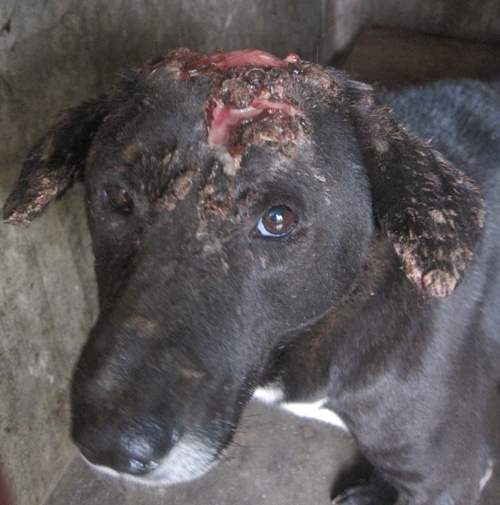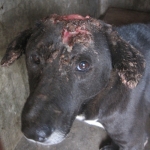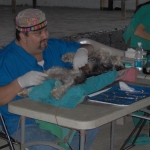KAT Centre i Nepal – 15. maj 2012:
 Så er der atter nyt fra KAT Centre i Nepal, som denne gang fortæller om, hvordan de har anvendt de midler, som Dyrenes SOS sendte KAT Centre i april 2012.[divider]
Så er der atter nyt fra KAT Centre i Nepal, som denne gang fortæller om, hvordan de har anvendt de midler, som Dyrenes SOS sendte KAT Centre i april 2012.[divider]
The Kathmandu Animal Treatment Centre (KAT Centre) thanks Animal SOS for the grant of US$1934 on 20 April 2011. The KAT Centre has expended all of the funds. This is a report on the use of the grant.
The KAT Centre’s two main programs are Animal Birth Control (ABC) and Rescue & Treatment. They are complemented by a Public Education program for children and adults which reduces animal cruelty and engenders compassionate behavior. Through school visits, community outreach, and distribution of printed materials, KAT teaches responsible pet ownership (including the importance of spaying and neutering), prevention of dog bites and rabies, and humane treatment for all animals, and encourages people to care for local street dogs. KAT also provides pet therapy at schools for disabled children and orphanages.
Animal Birth Control:
A goal of KAT’s ABC program is to sterilize (spay) enough female street dogs so that the canine population becomes stable, instead of breeding until there are not enough resources for all the dogs to survive. This is a sustainable solution which prevents thousands of homeless puppies from being born into lives of suffering and has an impact that goes far beyond the animals treated at the Centre. ABC has been proven as an effective and humane means of population control in many other cities. Every dog is also vaccinated for rabies, to help KAT accomplish its goal of eliminating rabies from the Kathmandu Valley.
The KAT Centre has conducted canine population surveys in collaboration with the World Society for the Protection of Animals (WSPA) and the World Health Organization (WHO) which have demonstrated the effectiveness of the program in Kathmandu. From 2006 to 2010, the percent of female street dogs in the urban area of Kathmandu who are sterilized (as indicated by a notch in their left ear) increased from 15% to 40%. In that same time period, the number of street dogs in this area decreased from approximately 31,000 to 22,500.
Last year, the KAT Centre continued its success. The organization sterilized and vaccinated 1,007 female street dogs in 2011. KAT is working through the urban part of Kathmandu, sterilizing all dogs it can find in one neighborhood and then moving to the next one. Provided adequate funding continues to be available, the organization will bring its ABC program to the entire city of Kathmandu.
Rescue & Treatment:
The Kathmandu Animal Treatment Centre’s Rescue & Treatment program supports and complements its Animal Birth Control program. Sterilizing street dogs is the most effective way to improve the well-being of the entire city’s street dog population. However, many dogs in Kathmandu are sick, injured, or abused, and the KAT Centre does not ignore them or leave them to suffer. The KAT Centre receives phone calls every day from concerned members of the public who ask the organization to help animals in need. Additionally, many people bring hurt and ill dogs and cats to the Centre, and KAT’s staff collects dogs in need while driving in animal ambulances. KAT’s vets and animal care staff give these animals any needed medical treatment. Every animal that enters the Rescue & Treatment program at the KAT Centre is also sterilized and vaccinated for rabies.
- This street dog was rescued by KAT because it had a head injury infected by maggots.
In 2011, the KAT Centre’s Rescue & Treatment program provided vital medical care to 573 dogs and cats in need. Many of them suffered from severe cases of mange, collisions with vehicles, open sores infected with maggots, malnutrition, and injuries from abuse by people.
Grant from Animal SOS:
The grant given by Animal SOS was essential to the success of both of these programs. The KAT Centre expended the funding to purchase the veterinary supplies and medicines that it used for the programs, as well as food for the dogs at the Centre. KAT uses a wide range of drugs; some of the most common ones are antibiotics for respiratory infections and intestinal illnesses, antiparasitic drugs, de-worming tablets, anesthetic for surgeries, pain relievers, and ivermectin for mange. Additionally, Animal SOS’s grant provided many of the vaccines used at KAT last year. Every animal that is treated at the Centre, in either the ABC or Rescue & Treatment program, is vaccinated for rabies. Dogs who live at the Centre for the long term and animals who are adopted also receive combination vaccines which protect them from distemper, parvovirus, hepatitis, leptovirus, and parainfluenza.
The KAT Centre shelters around 50 animals, including dogs who are being sterilized for the Animal Birth Control (ABC) program, animals receiving medical treatment, and animals who are waiting to be adopted. The grant helped to pay the considerable expense of providing food to these animals. The Kathmandu Animal Treatment Centre is grateful to Animal SOS for its generous support. This grant has made it possible for KAT to continue to work toward its goals of creating a healthy, stable canine population and eliminating rabies throughout the Kathmandu Valley. As a result of KAT’s efforts, the dog population, as well as the suffering of animals, will continue to decrease.
Please let me know if you have any questions or if you would like more information.
Gregg Tully
Development and Coummnications Manager
Kathmandu Animal Treatment Centre
development@katcentre.org.np







